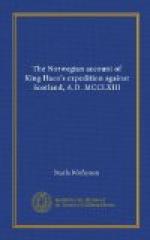During this voyage King Haco had that great vessel which he had caused to be constructed at Bergen. It was built entirely of oak, and contained twenty-seven banks of oars.[21] It was ornamented with heads and necks of dragons beautifully overlaid with gold. He had also many other well-appointed ships.
In the spring King Haco sent John-Langlife-son and Henry Scot west to the Orkneys, to procure pilots for Shetland. From thence John sailed to the Hebrides and told King Dugal that he might expect an army from the East. It had been rumoured that the Scots would plunder in the islands that summer. King Dugal, therefore, spread abroad a report that forty ships were coming from Norway. And by this means he prevented the Scotch from making a descent.
Some time before the King himself was ready, he sent eight ships to the westward. The Captains of these were Ronald Urka, Erling Ivarson, Andrew Nicolson, and Halvard Red. They continued some days out in the road, as the wind did not favour them.
When the King had prepared his ship, he removed all his army from the capital to Eidsvags;[22] afterwards he himself returned to the city, where he remained some nights, and then set out for Herlover.[23] Here all the troops, both from the Northern and Southern districts, assembled, as is described in the Ravens-ode, which Sturla[24] sung.
1.
From the recesses of Finland,[25] bands, keen for battle, sought the potent Ruler of the storm of Javelins. The boisterous deep, that girds this earth, bore the ships of the Protector of thrones west from the streams of Gotelfa.
King Haco mustered all his force at Herlover. It was a mighty and splendid armament. The King had many large and well-appointed ships, as is thus described.
2.
No terrifier of dragons,[26] guardians of the hoarded treasure,[27] e’er in one place beheld more numerous hosts. The stainer of the sea-fowl’s beak,[28] resolved to scour the main, far distant shores connected by swift fleets.
3.
A glare of light blazed from the powerful, far-famed monarch while, carried by the sea-borne wooden coursers[29] of Gestils,[30] he broke to the roaring waves. The swelling sails, of keels that ride the surge, reflected the beams of the unsullied sun around the umpire of wars.
Some nights after King Haco had arrived at Herlover, Ronald and Erling sailed out of the bay with their squadron. Ronald was separated from the rest at sea, and made for the Orkneys with some of the ships. But, Erling, and Andrew, and Halvard steered south before Shetland, and so to the west of Tharey-fiord;[31] and they saw no land; except Sulna-stapa[32] west of the Orkneys. Afterwards they sailed in to Scotland under Dyrness.[33] They went up into the country and destroyed a castle, but the garrison had fled. They burned more than twenty hamlets. Next they steered for the Hebrides, and found there Magnus King of Man.




